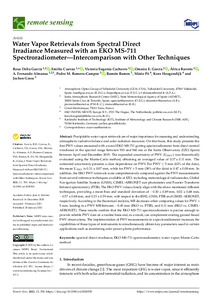Por favor, use este identificador para citar o enlazar este ítem:
http://hdl.handle.net/20.500.11765/12664
Water vapor retrievals from spectral direct irradiance measured with an EKO MS-711 spectroradiometer—intercomparison with Other Techniques
| Título : | Water vapor retrievals from spectral direct irradiance measured with an EKO MS-711 spectroradiometer—intercomparison with Other Techniques |
| Autor : | García Cabrera, Rosa Delia

 ; Cuevas Agulló, Emilio
; Cuevas Agulló, Emilio











|
| Palabras clave : | Spectral direct irradiance; Spectroradiometers; Water vapor; Monte-Carlo method |
| Fecha de publicación : | 2021 |
| Editor: | Multidisciplinary Digital Publishing Institute |
| Citación : | Remote Sensing. 2021, 13(30), 350 |
| Versión del editor: | https://dx.doi.org/10.3390/rs13030350 |
| Resumen : | Precipitable water vapor retrievals are of major importance for assessing and understanding atmospheric radiative balance and solar radiation resources. On that basis, this study presents the first PWV values measured with a novel EKO MS-711 grating spectroradiometer from direct normal irradiance in the spectral range between 930 and 960 nm at the Izaña Observatory (IZO, Spain) between April and December 2019. The expanded uncertainty of PWV (UPWV) was theoretically evaluated using the Monte-Carlo method, obtaining an averaged value of 0.37 ± 0.11 mm. The estimated uncertainty presents a clear dependence on PWV. For PWV ≤ 5 mm (62% of the data), the mean UPWV is 0.31 ± 0.07 mm, while for PWV > 5 mm (38% of the data) is 0.47 ± 0.08 mm. In addition, the EKO PWV retrievals were comprehensively compared against the PWV measurements from several reference techniques available at IZO, including meteorological radiosondes, Global Navigation Satellite System (GNSS), CIMEL-AERONET sun photometer and Fourier Transform Infrared spectrometry (FTIR). The EKO PWV values closely align with the above mentioned different techniques, providing a mean bias and standard deviation of −0.30 ± 0.89 mm, 0.02 ± 0.68 mm, −0.57 ± 0.68 mm, and 0.33 ± 0.59 mm, with respect to the RS92, GNSS, FTIR and CIMEL-AERONET, respectively. According to the theoretical analysis, MB decreases when comparing values for PWV > 5 mm, leading to a PWV MB between −0.45 mm (EKO vs. FTIR), and 0.11 mm (EKO vs. CIMEL-AERONET). These results confirm that the EKO MS-711 spectroradiometer is precise enough to provide reliable PWV data on a routine basis and, as a result, can complement existing ground-based PWV observations. The implementation of PWV measurements in a spectroradiometer increases the capabilities of these types of instruments to simultaneously obtain key parameters used in certain applications such as monitoring solar power plants performance. |
| Patrocinador: | This study has been performed thanks to regular funds from the State Meteorological Agency of Spain (AEMET) to the World Meteorological Organization (WMO) Commission for Instruments and Methods of Observations (CIMO) Izaña Testbed for Aerosols and Water Vapor Remote Sensing Instruments and the European Community Research Infrastructure Action under the FP7 ACTRIS grant, agreement no. 262254. |
| URI : | http://hdl.handle.net/20.500.11765/12664 |
| ISSN : | 2072-4292 |
| Colecciones: | Artículos científicos 2019-2022 |
Ficheros en este ítem:
| Fichero | Descripción | Tamaño | Formato | ||
|---|---|---|---|---|---|
| remotesensing-13-0035... | 1,17 MB | Adobe PDF |  Visualizar/Abrir |
Los ítems de Arcimis están protegidos por una Licencia Creative Commons, salvo que se indique lo contrario.





